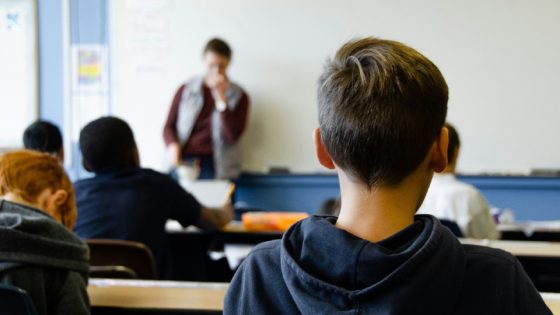Secondary schools with the most disadvantaged pupils saw spending per pupil fall by 12% in real terms between 2010 and 2021, compared with 5% for schools in the most affluent areas.
Amongst early years providers, extra funding for disadvantaged children has declined from a 60% add-on to the core hourly funding rate in 2017, down to about 38% extra in 2023.
These are among the main conclusions of the new ‘Annual Report on Education Spending in England: 2023’ by researchers at the Institute for Fiscal Studies, published and funded by the Nuffield Foundation. This year’s report has a special focus on geographical differences, and the levels of funding targeted at disadvantaged children and young people.
The report also finds that rising costs are placing increasing pressure on all areas of education.
- Once early years providers’ costs are accounted for, the core hourly funding rate for 3- and 4-year-olds will be about 12% lower in real terms in 2024 than in 2012.
- The purchasing power of school budgets will be about 4% lower in 2024 than in 2010 if we account for likely cost increases, such as staff salary rises.
- Spending per student in colleges in 2024 will be about 10% below 2010 levels, and 23% below them in school sixth forms.
- Cash-terms freezes in higher education tuition fees have reduced the real-terms value of spending per student, taking the level in 2024 back to 2011 levels.
Other key findings from the report:-
Early years set for spending boost, but rising costs and deprivation stretch budgets
- New entitlements set to increase spending. From September 2025, all children under 5 in working families will be entitled to up to 30 hours of funded childcare a week from 9 months old. These new entitlements will mean that free entitlement spending doubles between this year and 2026–27.
- Providers’ budgets being eroded by rising costs. Even with additional funding, we estimate that core funding per hour for 3- and 4-year-olds in 2024 will be 12% below its level in 2012 once we take into account providers’ costs, such as rising rents and increases in the National Living Wage.
- Funding for deprivation spread more thinly. The most deprived fifth of local authorities receive hourly resources that are 12% higher than those for areas in the most affluent fifth. This extra funding for deprivation is being spread more thinly. Children from deprived backgrounds received a 60% boost to core hourly funding in 2017, which was down at 38% extra in 2023. This fall reflects an illogical funding system where funding for deprivation is constrained to be 8% of total funding, despite the number of children classified as deprived having increased.
Rising school costs and larger cuts for schools serving more disadvantaged students
- Return to 2010 school spending levels is put at risk by rising costs. Government spending plans imply a real-terms increase of more than 9% in spending per student in schools between 2019 and 2024. In reality, costs facing schools have risen faster than overall inflation and the real resources available to schools have only risen by 5%. So instead of getting the purchasing power of school budgets per pupil back to 2010 levels, as intended, it will still be 4% lower in 2024.
- Schools serving more disadvantaged pupils have seen larger spending cuts over time. The most deprived fifth of secondary schools saw spending per pupil fall by 12% in real terms between 2010 and 2021, compared with 5% for the least deprived fifth. This has reduced the funding advantage for the most disadvantaged schools from 31% extra in 2010 to about 21% extra in 2021.
- Support for socio-economic deprivation in the school funding system has fallen. There has been a 14% real-terms reduction in the value of the Pupil Premium since 2015. The introduction of statutory minimum funding levels in 2020 disproportionately benefited less deprived schools. When the National Funding Formula was introduced in 2018, a decision was made to reduce funding for socio-economic disadvantage and increase funding for schools with low prior attainment. This funding shift only partially compensated the most deprived schools for reductions in deprivation funding over time.
Spending per student in further education colleges and sixth forms still well below 2010 levels
- Large spending cuts have not been reversed. Even with £1.6 billion in additional funding announced in the 2021 Spending Review, we estimate that college spending per student aged 16–18 in 2024 will still be about 10% below 2010 levels, and about 23% below them for school sixth forms. Recent funding announcements have not changed this picture as they all came from existing budgets.
- Extra funding for disadvantaged students and FE colleges. Spending per student is about 9% higher in the most deprived areas than in the least deprived areas in 2023, up from about 4–5% in 2013. This reflects higher funding for students from deprived areas and the fact that FE colleges, which are more prevalent in more deprived areas, receive higher funding per student (£7,100 in 2023) than sixth forms (£5,400–£5,800).
Higher education spending and maintenance support eroded by inflation over time
- Spending per student in higher education set to return to low point of 2011. Successive cash-terms freezes in tuition fees over time are due to reduce higher education spending per student in 2024 by 24% in real terms compared with 2012. This will take it back to the same level as its low point in 2011, just before the increase in fees to £9,000 in 2012 – and, remarkably, 3% lower than in 1990.
- Reduced value of maintenance support due to higher-than-expected inflation. Students in 2023–24 will be entitled to borrow 11% less towards their living costs than they were in 2020–21, a cut equivalent to £107 a month for the poorest students.
- Socio-economic inequalities in higher education participation mean spending is focused on more affluent students. Higher education spending per young person in each local authority largely depends on the share who participate in higher education, which is higher in more affluent areas. As a result, spending per young person is lowest for young people from Northamptonshire and Blackpool, and highest for young people from London.
Luke Sibieta, IFS Research Fellow and an author of the report, said: “Education providers face a multitude of budget challenges. Rising inflation and costs are eroding the real-terms value of budgets across the early years, schools, colleges and universities alike. At the recent Autumn Statement, the government chose not to top up education spending plans, but instead focus on reducing taxes. We also see that schools serving the most disadvantaged children have faced the biggest spending cuts over time, and support for disadvantaged students in colleges and sixth forms is still relatively modest. Schools will have benefited from decisions to increase deprivation funding this year. However, we have seen increases in educational inequalities since the pandemic, growing hardship due to the rising cost of living, and severe strain on children’s social services. This magnifies the challenges faced by nurseries, schools and colleges serving the most disadvantaged communities.”
Josh Hillman, Director of Education at the Nuffield Foundation, said: “This important report shines a light across the education funding landscape, helping hold the government to account on its real-terms spending plans for provision for pupils and students in different phases. It shows that aspirations to “level up” education achievement and opportunities both in geographic terms and in narrowing the socio-economic disadvantage gap are being stifled by a range of funding policies and trends.”
Photo by Scott Graham on Unsplash






Leave a Reply